Content
All issues / Volume 17 (2023) / Issue 11 (November)
Andrea Toldy
Vol. 17., No.11., Pages 1081-1081, 2023
DOI: 10.3144/expresspolymlett.2023.81
Vol. 17., No.11., Pages 1081-1081, 2023
DOI: 10.3144/expresspolymlett.2023.81
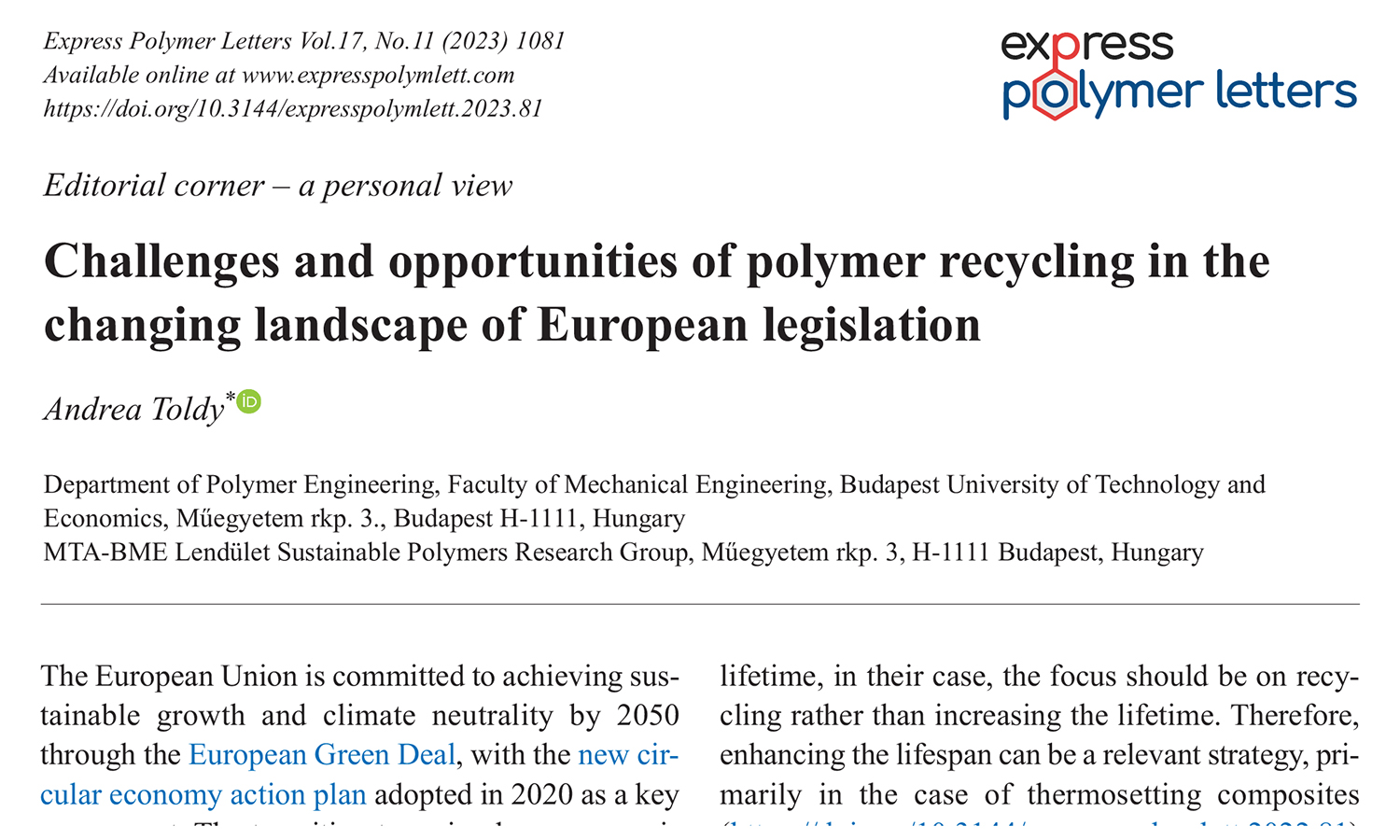
This is an editorial article. It has no abstract.
Kianoosh Soltanmohammadi, Mohammad Aberoumand, Davood Rahmatabadi, Elyas Soleyman, Sogol Ghasemi, Ismaeil Ghasemi, Majid Baniassadi, Karen Abrinia, Mahdi Bodaghi, Mostafa Baghani
Vol. 17., No.11., Pages 1082-1095, 2023
DOI: 10.3144/expresspolymlett.2023.82
Vol. 17., No.11., Pages 1082-1095, 2023
DOI: 10.3144/expresspolymlett.2023.82

There
are a limited number of thermoplastics with intrinsic shape memory effect (SME)
that are four-dimensional (4D) printable. Development of other shape memory
polymers (SMPs) entails synthesis with a complicated chemical experimental lab
effort. In this paper, for the first time, a novel layered multi-material
structure is developed based on a deep comprehension of SMEs’ macromolecular
requisites. The fused deposition modeling (FDM) method is used for the
four-dimensional printing of layered structures whose base materials show no
SME. Commercial acrylonitrile butadiene styrene (ABS), toughened
ABS-thermoplastic polyurethane (TPU) blend, and TPU, all with no SME, are used
to fabricate bi-layers of ABSTPU blends and TPU with different volumetric
proportions. Different thermo-mechanical tests, including dynamic mechanical thermal
analysis (DMTA), and constrained and free shape recovery, are conducted. Also,
the interfacial properties of the layered 4D printed structure are assessed by
the mean of shear testing and scanning electron microscopy (SEM). Experimental results
reveal that the 4D printed bi-layer composites possess a high level of
programmability, SME (90–96%), and perfect interfaces without any porosity and
detachment between layers. The results of this research can potentially
eliminate the desperate need for SMPs for 4D printing and broaden the
opportunity to have smart parts using commercial thermoplastics.
Jareerat Ruamcharoen, Ruszana Munlee, Lapporn Vayachuta, Polphat Ruamcharoen
Vol. 17., No.11., Pages 1096-1109, 2023
DOI: 10.3144/expresspolymlett.2023.83
Vol. 17., No.11., Pages 1096-1109, 2023
DOI: 10.3144/expresspolymlett.2023.83

Sago
starch (SS) was blended with natural rubber (NR) using nanoclays, namely
montmorillonite (MMT), kaolinite (KAO), and kaolinite modified by dimethyl
sulfoxide (KAO-D) to enhance its physical and mechanical properties. Each nanoclay
was incorporated at 2, 4, 6, and 8 wt%, respectively. The SS80NR20 (80 wt% of
sago starch and 20 wt% of natural rubber) biocomposites were characterized by
solubility of water, water vapor transmission, mechanical and thermal
properties. The constituent interaction and morphology of the SS80NR20
biocomposites were also presented by using X-ray diffraction (XRD) technique
and scanning electron microscope (SEM). The findings demonstrated that the
inclusion of clays significantly improved both the water resistance and tensile
properties when compared to the SS80NR20 blend. In the SS80NR20 biocomposites,
MMT at 6 wt% exhibited the lowest moisture content, solubility in water, and
water vapor transmission. As the amount of nanoclay in the biocomposites
increased, their tensile strength dramatically increased whilst their strain at
break had a tendency to diminish. Strong interaction by establishing the
intercalated structure of MMT, and KAO within SS80NR20 biocomposites were
attributed to both physical and mechanical properties, while the weak
interaction at the interface of SS and NR was attributed to KAO-D.
Sona Zenzingerova, Michal Kudlacek, Jana Navratilova, Lenka Gajzlerova, David Jaska, Lubomir Benicek, Roman Cermak
Vol. 17., No.11., Pages 1110-1120, 2023
DOI: 10.3144/expresspolymlett.2023.84
Vol. 17., No.11., Pages 1110-1120, 2023
DOI: 10.3144/expresspolymlett.2023.84
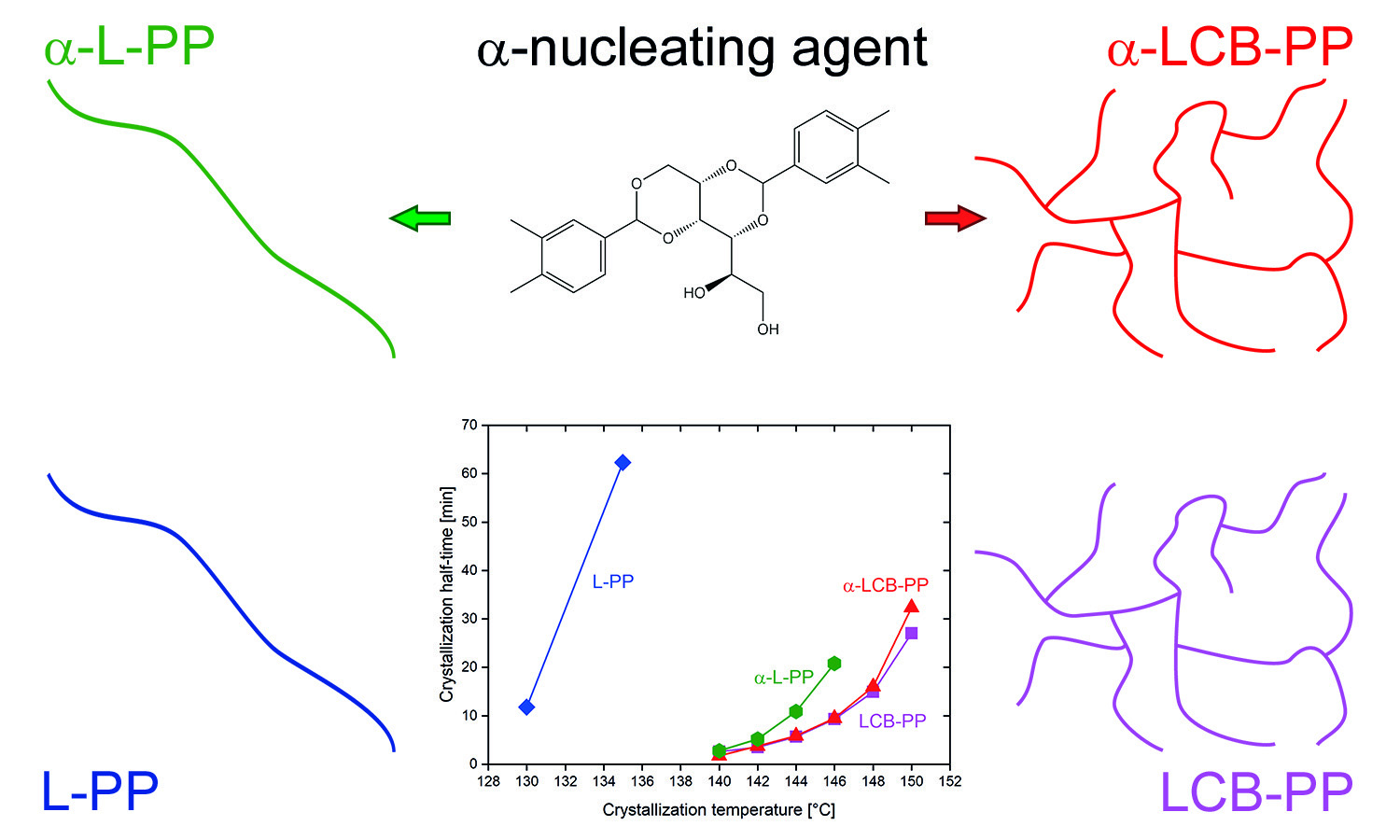
The
main purpose of this work is to present the effect of long-chain branching and
specific α-nucleation on the optical properties, crystallization and
supermolecular structure of polypropylene (PP). Commercially available α-nucleating/clarifying
agent 1,3;2,4-bis(3,4-dimethylbenzylidene)sorbitol (Millad 3988) was mixed into
linear PP and long-chain branched PP (LCB-PP) in the concentration of 0.2 wt%.
For the study of polymorphic composition, crystallinity, and crystallization process
under isothermal conditions in the temperature range of 130–150 °C,
differential scanning calorimetry and wide-angle X-ray scattering were used.
Although the used nucleating/clarifying agent appears to have a slight effect
on the optical properties of long-chain branched polypropylene, it does not
appear to affect the crystallization kinetics significantly. LCB-PP exhibited
self-nucleation, favored over nucleation by a specific nucleating agent.
Synthesis and characteristics of α-carboxylic, ω-hydroxyl natural rubber toughened poly(lactic acid)
Abdulhakim Masa, Varaporn Tanrattanakul, Ruedee Jaratrotkamjorn
Vol. 17., No.11., Pages 1121-1134, 2023
DOI: 10.3144/expresspolymlett.2023.85
Vol. 17., No.11., Pages 1121-1134, 2023
DOI: 10.3144/expresspolymlett.2023.85
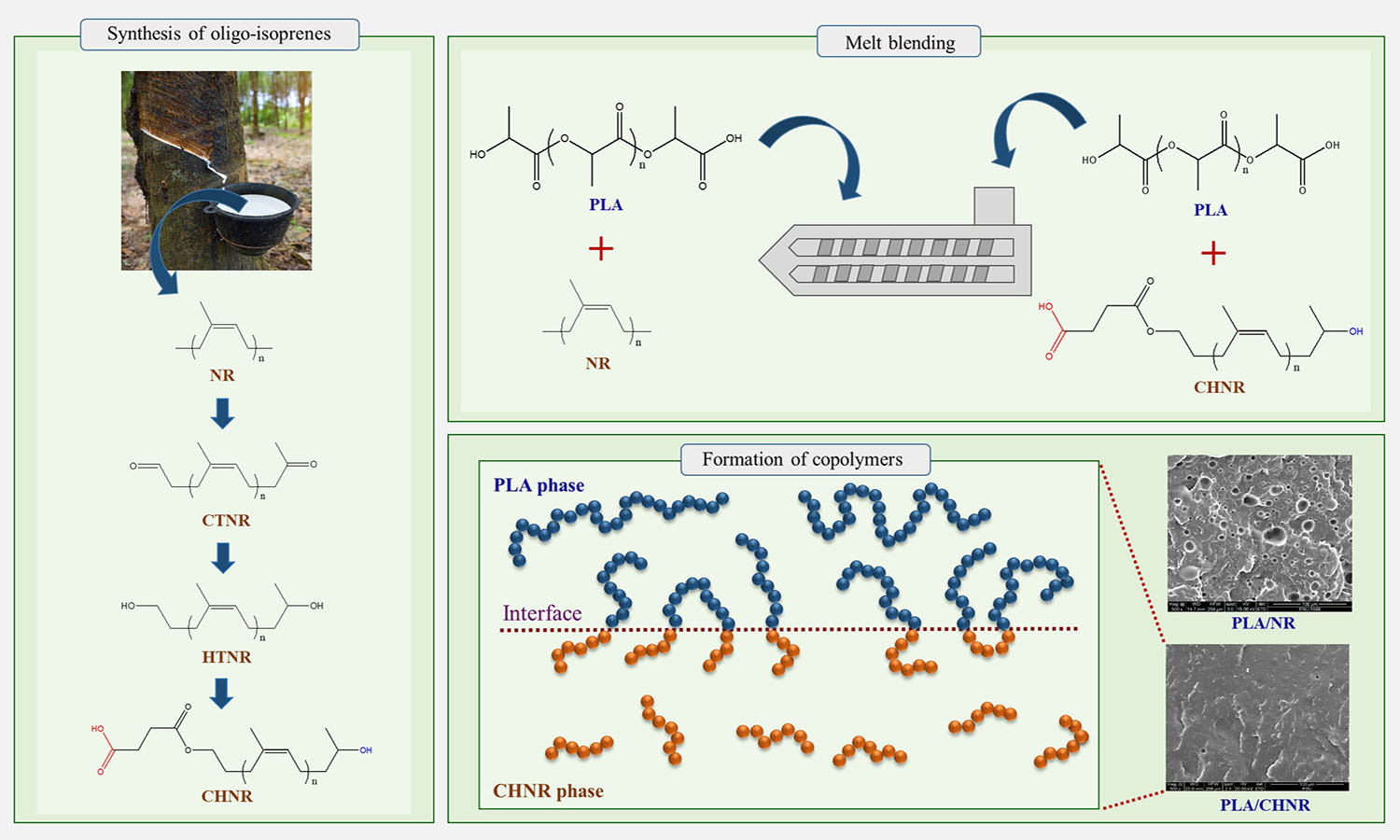
This work presented the synthesis of α-carboxyl, ω-hydroxyl natural rubber (CHNR) for use as an alternative toughening agent for poly(lactic acid) (PLA). The proton nuclear magnetic resonance spectroscopy (1H-NMR) and Fourier transform infrared spectroscopy (FTIR) analyses verified the chemical structure of CHNR consisting of the hydroxyl and carboxyl end groups. The molecular weights of CHNR were set from 5000 to 15 000 g·mol–1 which were determined by gel permeation chromatography (GPC) and 1H-NMR. The PLA and CHNR were prepared by reactive blending using a twinscrew extruder. It was found that the reaction between PLA and CHNR proceeded through transesterification without a catalyst. The formation of copolymer (PLA-co-CHNR) at the interface of PLA and CHNR increased the interfacial adhesion between the two phases. Differential scanning calorimetry (DSC) analysis revealed that CHNR was more compatible with PLA than natural rubber (NR). The compatibilization affected the blend morphology by reducing the interfacial tension. It resulted in a reduction of rubber particle size. The CHNR with a molecular weight of 5000 g·mol–1 showed the greatest improvement in the toughness and ductility of PLA.
Nicolas Candau, Rachel LeBlanc, Maria Lluisa Maspoch
Vol. 17., No.11., Pages 1135-1153, 2023
DOI: 10.3144/expresspolymlett.2023.86
Vol. 17., No.11., Pages 1135-1153, 2023
DOI: 10.3144/expresspolymlett.2023.86
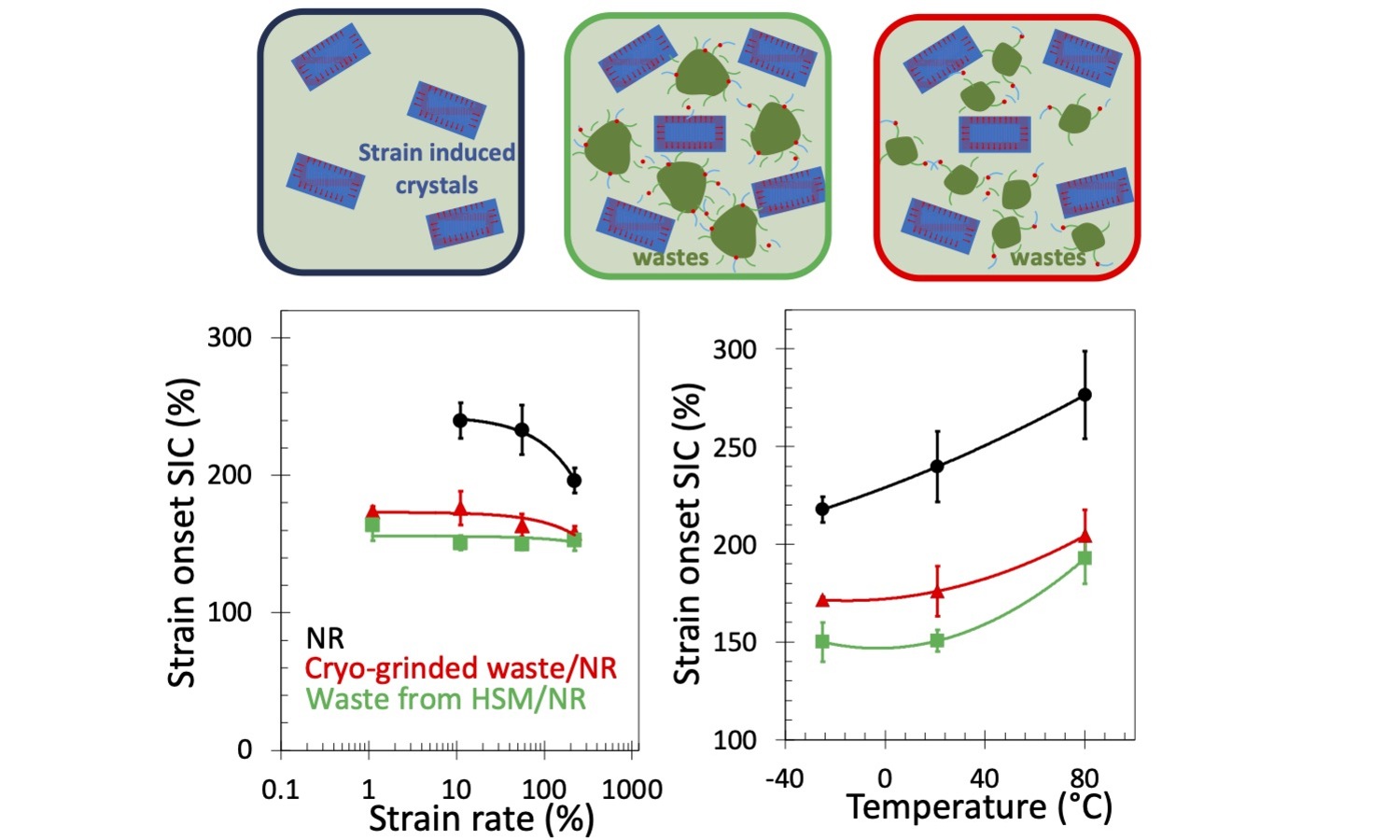
The
influence of the type of mechanical recycling of waste rubber particles on the
tensile properties of waste/natural rubber blends has been investigated. The
wastes originating from ground tyre rubber (GTR) had been treated by two
distinct processes: cryo-grinding and high shear mixing (HSM). For both
processes, the resulting composites show enhanced stiffness and strength for
all strain rates and temperatures tested. This is attributed to both the
reinforcing effect of the waste as well as the nucleation ability of the wastes
on strain induced crystallization (SIC) in the natural rubber (NR) matrix.
Cryo-grinding was shown to provide the finest particle size with an average
diameter of 34 μm, while the HSM process was found to show an elastic modulus
of aggregated GTR powder of 7 MPa at 1 Hz at room temperature. Within these
characteristics, the NR/GTR blends using the HSM process show the best tensile
performance under single loading, with the highest strength and highest ability
to crystallize under strain. Under cyclic loading, NR/GTR blends using
cryo-ground GTR particles show the best performance, which we ascribed to their
ability to better distribute and accommodate the stress from one cycle to another
owing to their finest size. Both explored recycling techniques provide the
natural/waste rubber blends interesting properties such as mechanical
reinforcement and strain-induced crystallization ability under various testing
conditions.
Limin You, Shifan Zhang, Zhuoxiong Huang, Wanle Pi, Jiaqi Liu, Rui Ma
Vol. 17., No.11., Pages 1154-1165, 2023
DOI: 10.3144/expresspolymlett.2023.87
Vol. 17., No.11., Pages 1154-1165, 2023
DOI: 10.3144/expresspolymlett.2023.87

In recent years, solid polymer electrolytes (SPE) has attracted much attention because of its good safety and environmental stability, among which poly(ε-caprolactone) (PCL) based solid electrolyte film is one of the most potential materials. We have adopted the method of synthesizing polymer nanocomposites with natural clay, which can effectively meet the needs of electrolytes. In this study, cetyl trimethyl ammonium bromide (CTAB) was used to modify rectorite (REC), and the ε-CL monomer is inserted between the rectorite silicate layers. PCL/organic rectorite (OREC) nanocomposites were synthesized by in situ intercalation polymerization. The yield of the polymer nanocomposite could reach 93.6% when the molecular weight of the polymer nanocomposite was 39 000. The effects of OREC addition on the morphology, thermal stability, and electrochemical properties of PCL/OREC nanocomposites were investigated by various characterization methods. The temperature can be increased by 50 °C when the thermal decomposition is 50 wt%, and the crystallinity decreases by 4.6%. Composite polymerelectrolytes (CPEs) (PCL/OREC) showed a good electrical conductivity of 1.13·10–4 S·cm–1 at 60 °C and an excellent capacity retention rate of 96.7% after 100 cycles at 0.5 C current density. This study has important guiding significance for the development of polymer nanocomposites as solid electrolytes.
Janka Bobek-Nagy, Róbert Kurdi, András Kovács, Lilla Simon-Stőger, Márton Szigeti, Csilla Varga
Vol. 17., No.11., Pages 1166-1179, 2023
DOI: 10.3144/expresspolymlett.2023.88
Vol. 17., No.11., Pages 1166-1179, 2023
DOI: 10.3144/expresspolymlett.2023.88
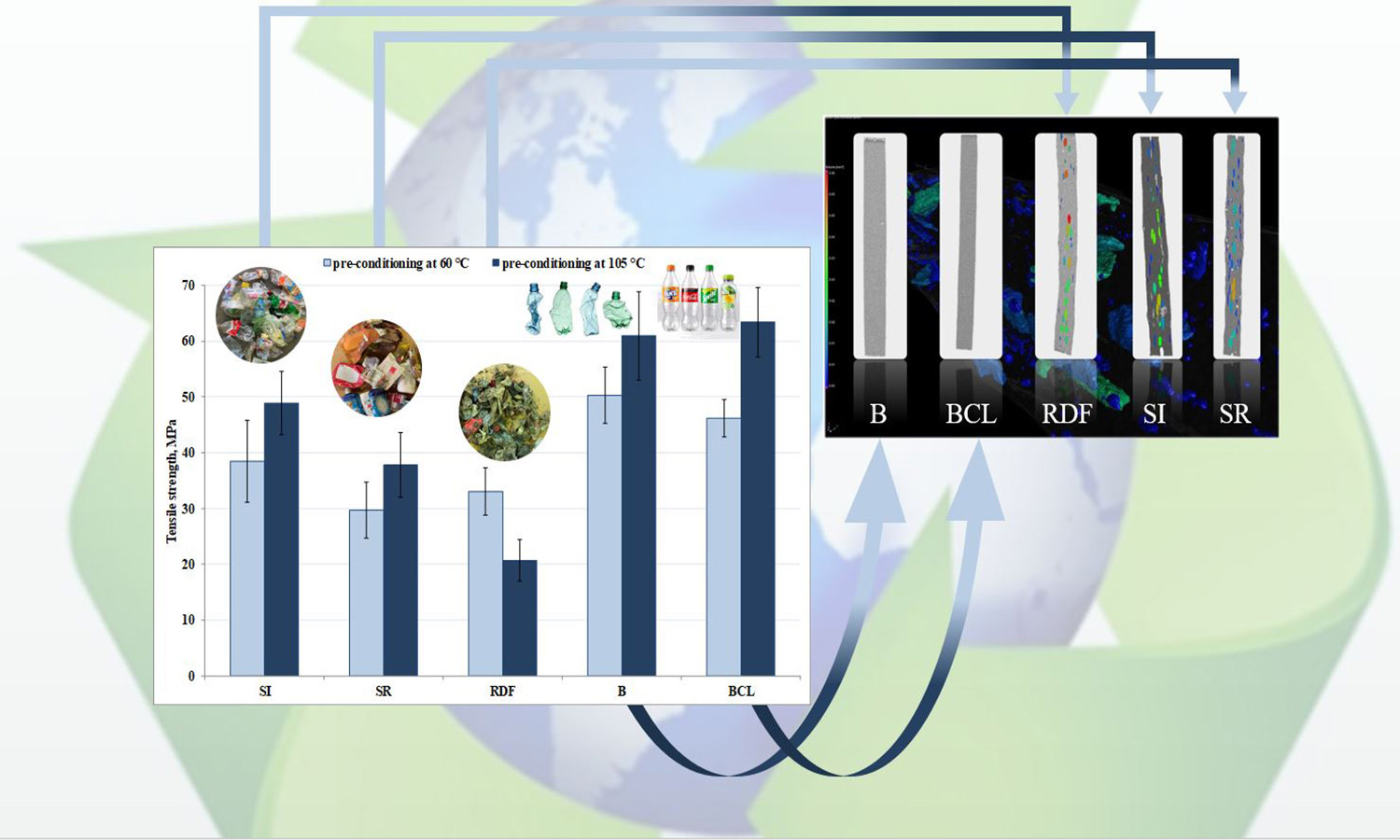
Under
the era of circular economy, the deposit-refund system (DRS) for e.g. polyethylene
terephthalate (PET) is thought to be a good choice to achieve a more structured
plastic recycling. The present research has the aim to make a comprehensive description
and a practical guideline in order to evaluate how collection and separation
system influence the quality and efficiency of mechanical recycling of PET. The
DRS has been symbolized by manually collected bottles with (BCL) and without
(B) caps and labels. Samples have been given from the selective income (SI) and
the sorting residue (SR) of a manual selective waste sorting plant and PET
fraction of refuse derived fuel (RDF). Based on preliminary qualification results
such as melt flow indices (MFI), PET bottles are worth selecting into the main
colours like water clear, blue, and all the others together, referred to as
PET-A, PET-B, and PET-D fractions of the sorting plant. The SR seemed to be a beneficial
raw material for PET recycling as both mechanical and rheological properties
were proper enough. PET separated from the Mechanical Biological Treatment
(MBT) plant as RDF showed the worst processing and mechanical properties, but
both can be improved with deeper precleaning. X-ray tomography (CT) scans have
shown a correlation between the source of waste and the gas void structure
which influence the macroscopic mechanical properties.


